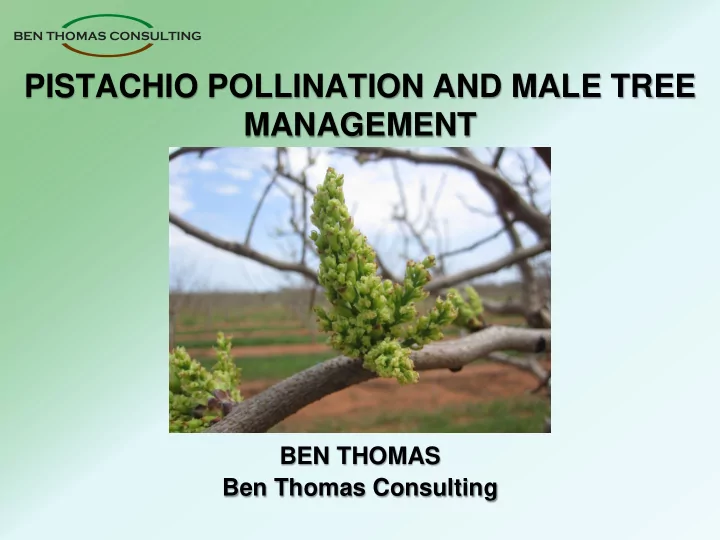

PISTACHIO POLLINATION AND MALE TREE MANAGEMENT BEN THOMAS Ben Thomas Consulting
PISTACHIO FLOWERS FEMALE MALE Slide 2
PISTACHIO FLOWERS • The pistachio tree is dioecious – Means ‘two houses’ – Male (staminate) flowers are borne on one tree and female (pistillate) flowers on another • A group of flowers is called a panicle and flowers are formed on a rachis • There can be hundreds of flowers per panicle but set is very low • Capable of parthenocarpy where the fruit grows but there is no viable embryo Slide 3
POLLINATION & FRUIT SET • STAGE 1 : Pollination • Pollen released from staminate flowers on male trees. • Carried by wind to stigmas of pistillate flowers on female trees • STAGE 2 : Pollen tube growth • Pollen grain on stigma germinates to form a pollen tube. • Pollen tube carrying male germ cells grows through stigma and style tissue to the ovule. • STAGE 3 : Fertilisation • Fusion of male and female germ cells in the ovule. Slide 4
PISTILLATE FLOWER ANATOMY - WALNUT Slide 5
PISTACHIO POLLINATION & ORCHARD DESIGN • Pistachio is wind pollinated – Male trees are interspersed through the orchard, usually in a regular pattern. – Initial plantings in Australia had 7-11% male trees but given the amount of pollen produced, more recent plantings use 4% male trees – Additional male trees can be planted in border rows but solid male tree rows are usually not needed. – Pistachio pollen can travel long distances Slide 6 Erdogan et al . (1998)
PLANTING DESIGNS • Traditional planting designs M F F M F F Male tree every 3 rd tree, every 3 rd row F F F F F F F F F F F F 1 male tree for 8 female trees M F F M F F F F F F F F 11.1% male trees F F F F F F M F F M F F F F F F F F F F F F F F Male tree every 5 th tree, every 3 rd row F F F F F F F F F F F F 1 male tree for 14 female trees M F F M F F F F F F F F 6.7% male trees F F F F F F F F F F F F F F F F F F Slide 7
PLANTING DESIGNS • Modern planting design M F F F F M F F F F F F F F F F F F F F F F F F F F F F F F Male tree every 5 th tree, every 5 th row F F F F F F F F F F F F F F F F F F F F 1 male tree for 24 female trees M F F F F M F F F F F F F F F F F F F F 4% male trees F F F F F F F F F F F F F F F F F F F F F F F F F F F F F F Slide 8
PISTACHIO POLLINATION & ORCHARD DESIGN • Pistachio is wind pollinated – Male trees are interspersed through the orchard, usually in a regular pattern. – Initial plantings in Australia had 7-11% male trees but given the amount of pollen produced, more recent plantings use 4% male trees – Additional male trees can be planted in border rows but solid male tree rows are usually not needed. • Sirora can have different stages of female flowers on the same branch – Bloom overlap is critical – Males with different flowering times are used to ensure there is pollen being released to cover the flowering times of Sirora – 3 males commonly used in Australia – ‘Green’ flowers early season – ‘Blue’ flowers mid season – ‘Red’ flowers late season Slide 9
SIRORA FLOWERING Slide 10
BLANKS • Blank nuts result when there is fruit set and ovary growth but the embryo fails to grow • Blanking during nut set – PARTHENOCARPY – Pollination occurs but fertilisation fails – Stimulus of pollination and/or pollen tube growth induces fruit set but the lack of fertilisation means that no embryo is formed so there is no kernel to fill the shell resulting in a blank – Boron nutrition. Low boron limits pollen germination and pollen tube growth • Blanking during nut fill – Blanks can develop during nut fill when the fertilised embryos fail to grow – Cause unknown but tree carbohydrate reserves suspected – Blanking is also sensitive to insufficient irrigation Slide 11
BLANKS Slide 12
MALE TREE MANAGEMENT • Male trees can be big! Slide 13
MALE TREE MANAGEMENT • Shading and crowding neighbouring female trees Slide 14
MALE TREE MANAGEMENT • Pruning male trees Slide 15
Recommend
More recommend